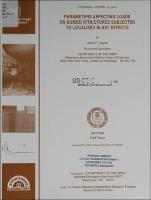Please use this identifier to cite or link to this item:
https://hdl.handle.net/11681/11139Full metadata record
| DC Field | Value | Language |
|---|---|---|
| dc.contributor | In-House Laboratory Independent Research Program (U.S.) | - |
| dc.contributor | United States. Assistant Secretary of the Army (R & D) | - |
| dc.contributor.author | Baylot, James T. | - |
| dc.date.accessioned | 2016-06-20T14:15:37Z | - |
| dc.date.available | 2016-06-20T14:15:37Z | - |
| dc.date.issued | 1992-04 | - |
| dc.identifier.uri | http://hdl.handle.net/11681/11139 | - |
| dc.description | Technical Report | - |
| dc.description | Abstract: Recent experiments have demonstrated that the current methodologies for predicting loads on buried structures resulting from the nearby detonation of a conventional weapon are not adequate. Errors in predicting the load could lead to significant errors in predicting the response of the structure. In analyses which have been performed in the past to determine the response of structures to conventional weapons, decoupling assumptions were made so that the detonation of the charge in the soil is not included in the calculation. In these analyses assumptions are made which affect the loads applied to the structure. A procedure which did not require these types of assumptions was needed to determine the characteristics of the loads transferred to the structure. This required that the charge, soil, and structure be modeled in the calculation. Based on its user's manual, the finite element program DYNA3D had all of the characteristics needed to conduct this investigation. After a preliminary review, it was determined that DYNA3D was not capable of performing these calculations without extensive modifications. These modifications included the implementation of a new Cap model for the soil. The new model was evaluated for its accuracy in reproducing free-field stresses for clay and sand, and can be used immediately adjacent to the explosive source. Due to large deformations and very high strains and strain rates in the soil near the charge, it was difficult to maintain the stability of the calculation. A method of maintaining this stability without adversely affecting the character of the free-field stress and velocity time-histories was developed and validated. A suitable method for simulating a nonreflecting boundary for soil responding inelastically was also developed. Calculations were performed for sand and clay soils to verify that DYNA3D with all of the modifications was capable of adequately predicting free-field stresses and velocities. These predictions agreed reasonably well with test data and indicated that the modified version of DYNA3D would be useful in investigating SSI. The nonreflecting boundary methodology was also verified. One-dimensional cylindrical and spherical geometry assumptions were imposed and analyzed to determine if it was reasonable to perform the SSI study using a two-dimensional (2-D) plane strain model. These analyses indicated that a charge can be selected for the plane strain calculation so that the peak stress, maximum velocity, and stress and velocity gradients at the center of the structure match those which are predicted using the correct charge and a three-dimensional geometry. A 2-D model was selected to study SSI. | - |
| dc.publisher | Structures Laboratory (U.S.) | - |
| dc.publisher | Engineer Research and Development Center (U.S.) | - |
| dc.relation | http://acwc.sdp.sirsi.net/client/en_US/search/asset/1035407 | - |
| dc.relation.ispartofseries | Technical report (U.S. Army Engineer Waterways Experiment Station) ; SL-92-9. | - |
| dc.rights | Approved for public release; distribution is unlimited. | - |
| dc.source | This Digital Resource was created from scans of the Print Resource | - |
| dc.subject | Buried structures | - |
| dc.subject | Underground structures | - |
| dc.subject | Conventional weapons | - |
| dc.subject | Finite element analyses | - |
| dc.subject | Ground shock | - |
| dc.subject | Loads on structures | - |
| dc.subject | Soil-structure interaction | - |
| dc.subject | Computer programs | - |
| dc.title | Parameters affecting loads on buried structures subjected to localized blast effects | - |
| dc.type | Report | en_US |
| Appears in Collections: | Technical Report | |
Files in This Item:
| File | Description | Size | Format | |
|---|---|---|---|---|
| TR-SL-92-9.pdf | 11.65 MB | Adobe PDF |  View/Open |